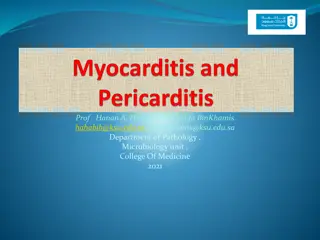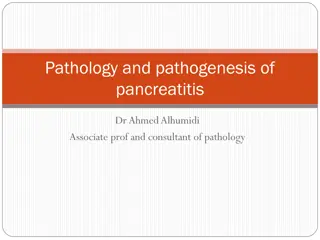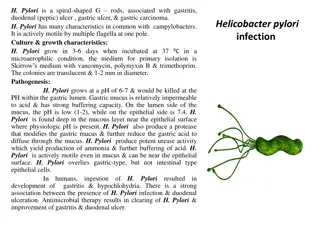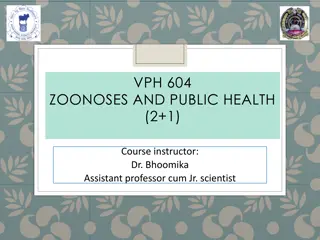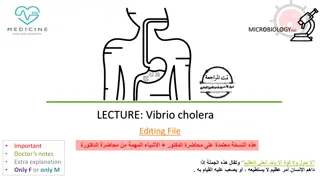Understanding Rickettsial Diseases: Epidemiology, Pathogenesis, and Clinical Features
Rickettsiae are pleomorphic intracellular coccobacilli with unique parasitic behavior, leading to vascular lesions and systemic manifestations in humans. The infections are spread by insect vectors and are characterized by fever, headache, malaise, skin rash, and organ enlargement. Different types of rickettsial diseases such as epidemic typhus, endemic typhus, and the spotted fever group have varying clinical presentations and severity levels.
Download Presentation

Please find below an Image/Link to download the presentation.
The content on the website is provided AS IS for your information and personal use only. It may not be sold, licensed, or shared on other websites without obtaining consent from the author. Download presentation by click this link. If you encounter any issues during the download, it is possible that the publisher has removed the file from their server.
E N D
Presentation Transcript
MEDICAL MICROBIOLOGY Asst. Prof. Dr. Dalya Basil Hanna
Rickettsiae Rickettsiae are pleomorphic intracellular coccobacilli that often have a transverse septum between two bacilli, reflecting division by binary fission. They do not stain well with Gram stain but are readily visible under the light microscope when stained with Giemsa's stain, acridine orange, or other stains.
Rickettsiae The obligate intracellular parasitism of rickettsiae has several interesting features. Failure to survive outside the cell is apparently related to requirements for nucleotide cofactors (coenzyme A, nicotinamide triphosphate (ATP). Outside the host cell, rickettsiae not only cease metabolic activity, but leak protein, nucleic acids, and essential small molecules. This instability leads to rapid loss of infectivity because the penetration of another cell requires energy. adenine dinucleotide) and adenosine
Epidemiology and Pathogenesis Most rickettsiae have animal reservoirs and are spread by insect vectors, which are prominent components of their life cycles. Rickettsial infections of humans usually result in clinical illness. Rickettsiae have a tropism for vascular endothelium, and the primary pathologic lesion is a vasculitis in which rickettsiae multiply in the endothelial cells lining the small blood vessels. Focal areas of endothelial proliferation and perivascular infiltration leading to thrombosis and leakage of red blood cells into the surrounding tissues account for the rash and petechial lesions. Vascular lesions occur throughout the body, producing the systemic manifestations of the disease, they are obviously most apparent in skin. The nature and role of any toxin in human disease are unknown.
Rickettsial Diseases Rickettsial infections are characterized by fever, headache, malaise, skin rash, and enlargement of the spleen and liver. 1. Epidemic typhus (Rickettsia prowazekii) In epidemic typhus, systemic infection are severe, and fever lasts for about 2 weeks. The disease is more severe and more often fatal in patients over 40 years of age. During epidemics, the case fatality rate has been 6 30%. 2. Endemic typhus (Rickettsia typhi) The clinical picture of endemic typhus has many features in common with that of epidemic typhus, but the disease is milder and is rarely fatal except in elderly patients.
Rickettsial Diseases 3. Spotted Fever Group The spotted fever group resembles typhus clinically; however, unlike the rash in other rickettsial diseases, the rash of the spotted fever group usually appears first on the extremities, moves centripetally, and involves the palms and soles. The case fatality rate varies greatly. In untreated Rocky Mountain spotted fever, it is usually much greater in elderly persons (up to 50%) than in young adults or children. Rickettsial pox is a mild disease with a rash resembling that of varicella. About a week before onset of fever, a firm red papule appears at the site of the mite bite and develops into a deep-seated vesicle that in turn forms a black eschar.
Rickettsial Diseases 4. Q Fever This encephalopathy rather than typhus. Transmission results from inhalation of dust contaminated with rickettsiae from placenta, dried feces, urine, or milk or from aerosols in slaughter houses. Infective endocarditis occasionally develops in chronic Q fever. Blood cultures for bacteria are negative. Virtually all patients have preexisting valve abnormalities. Continuous treatment with tetracycline for many months, occasionally with valve replacement, can provide prolonged survival. disease resembles influenza, nonbacterial pneumonia, hepatitis, or
Laboratory Diagnosis & Treatment Serologic tests are widely used in diagnosis of rickettesia. An antibody rise should be demonstrated during the course of the illness. In Rocky Mountain spotted fever, the antibody response may not occur until after the second week of illness. The polymerase chain reaction has been used to help diagnose Rocky Mountain spotted fever. The sensitivity of the method for Rocky Mountain spotted fever is about 70%, comparable to that of skin biopsy with immunocytology. Tetracyclines are effective provided treatment is started early. Tetracycline is given daily orally and continued for 3 4 days after defervescence. In severely ill patients, the initial doses can be given intravenously. Chloramphenicol also can be effective.
Mycoplasmas There are over 150 species in the class of cell wall-free bacteria. At least 15 of these species are thought to be of human origin. In humans, four species are of primary importance: Mycoplasma pneumoniae causes pneumonia and has been associated with joint and other infections. Mycoplasma hominis sometimes causes postpartum fever and has been found with other bacteria in uterine tube infections. Ureaplasma urealyticum is a cause of nongonococcal urethritis in men and is associated with lung disease in premature infants of low birth weight. Mycoplasma genitalium is closely related to M pneumoniae and has been associated with urethral and other infections. The smallest genome of mycoplasmas, M genitalium, is little more than twice the genome size of certain large viruses. Mycoplasmas are the smallest organisms that can be free-living in nature and self replicating on laboratory media.
General Characteristics of Mycoplasmas 1- The smallest mycoplasmas are 125 250 nm in size. 2- They are highly pleomorphic because they lack a rigid cell wall and instead are bounded by a triple-layered "unit membrane" that contains a sterol (mycoplasmas require the addition of serum or cholesterol to the medium to produce sterols for growth). 3- Mycoplasmas are completely resistant to penicillin because they lack the cell wall structures at which penicillin acts, but they are inhibited by tetracycline or erythromycin. 4- Mycoplasmas can reproduce in cell-free media; on agar, the center of the whole colony is characteristically embedded beneath the surface. 5- Growth of mycoplasmas is inhibited by specific antibody. 6- Mycoplasmas have an affinity for mammalian cell membranes.
Pathogenesis Many pathogenic mycoplasmas have flask-like or filamentous shapes and have specialized polar tip structures that mediate adherence to host cells. These structures are a complex group of interactive proteins, adhesins, and adherence-accessory proteins. The proteins are proline-rich, which influences the protein folding and binding and is important in the adherence to cells. The mycoplasmas attach to the surfaces of ciliated and nonciliated cells. Some mycoplasmas lack the distinct tip structures but use adhesin proteins or have alternative mechanisms to adhere to host cells. The subsequent events in infection are less well understood but may include several factors as follows: direct cytotoxicity through generation of hydrogen peroxide and superoxide radicals; cytolysis mediated chemotaxis and action of mononuclear cells; and competition for and depletion of nutrients. by antigen antibody reactions or by
Mycoplasma pneumoniae & Atypical Pneumonias M pneumoniae is a prominent cause of pneumonia, especially in persons 5 20 years of age. M pneumoniae is transmitted from person to person by means of infected respiratory secretions. Infection is initiated by attachment of the organism's tip to a receptor on the surface of respiratory epithelial cells. extracellular. Mycoplasmal pneumonia is generally a mild disease. The clinical spectrum of M pneumoniae infection ranges from asymptomatic infection to serious pneumonitis, with occasional neurologic and hematologic involvement and a variety of possible skin lesions. During infection, the organisms remain
Mycoplasma pneumoniae & Atypical Pneumonias The incubation period varies from 1 to 3 weeks. The onset is usually insidious, with lassitude, fever, headache, sore throat, and cough. Initially, the cough is nonproductive, but it is occasionally paroxysmal. Later there may be blood-streaked sputum and chest pain. Complications are uncommon, but hemolytic anemia may occur. The most common pathologic findings are interstitial and bronchiolitis. peribronchial pneumonitis and necrotizing The diagnosis of M pneumoniae pneumonia is largely made by the clinical recognition of the syndrome. Laboratory tests are of secondary value. The white cell count may be slightly elevated. Polymerase chain reaction (PCR) assay of specimens from throat swabs or other clinical material can be diagnostic, but is generally performed only in reference laboratories. Tetracyclines or erythromycins can produce clinical improvement but do not eradicate the mycoplasmas.
Mycoplasma hominis M hominis is strongly associated with infection of the uterine tubes (salpingitis) and tubo-ovarian abscesses; the organism can be isolated from the uterine tubes of about 10% of patients with salpingitis but not from women with no signs of disease. Women with salpingitis more commonly have antibodies against M hominis than women with no disease. M hominis has been isolated from the blood of about 10% of women who have postabortal or postpartum fever and occasionally from joint fluid cultures of patients with arthritis.
Ureaplasma urealyticum U urealyticum, like M hominis, has been associated with a variety of diseases but is a demonstrated cause in only a few of them. U urealyticum, which requires 10% urea for growth, probably causes nongonococcal urethritis in some men, but a majority of cases of nongonococcal urethritis are caused by Chlamydia trachomatis. U urealyticum is common in the female genital tract, where the association with disease is weak. U urealyticum has been associated with lung disease in premature low-birth- weight infants who acquired the organism during birth, but a causal effect has not been clearly demonstrated. The evidence that U urealyticum is associated with involuntary infertility is at best marginal.
Mycoplasma genitalium M nongonococcal urethritis, but culture of M genitalium is difficult, and subsequent observations have been based on data obtained by using the PCR, molecular probes, and serologic tests. The data suggest that M genitalium in men is associated with some cases of acute as well as chronic nongonococcal urethritis. In women, M genitalium has been associated with a variety of infections such as cervicitis, endometritis, salpingitis, and infertility. genitalium was originally isolated from urethral cultures of two men with
Treatment Many strains of mycoplasmas are inhibited by a variety of antimicrobial drugs, but most strains are resistant to penicillins, cephalosporins, and vancomycin. Tetracyclines and erythromycins are effective both in vitro and in vivo and are, at present, the drugs of choice in mycoplasmal pneumonia. Some ureaplasmas are resistant to tetracycline.
Cell Wall-Defective Bacteria L phase variants (L forms) are wall-defective microbial forms that can replicate serially as non rigid cells and produce colonies on solid media. Some L phase variants are stable; others are unstable. Wall-defective forms are not genetically related to mycoplasmas. They can result from spontaneous mutation or from the effects of chemicals. Treatment of eubacteria with cell wall-inhibiting drugs or lysozyme can produce cell wall-defective microbial forms.
Cell Wall-Defective Bacteria Protoplasts are such forms usually derived from gram-positive organisms; they are osmotically fragile, with external surfaces free of cell wall constituents. Spheroplasts are cell wall-defective forms usually derived from gram-negative bacteria; they retain some outer membrane material. Cell wall-defective forms continue to synthesize some antigens that are normally located in the cell wall of the parent bacteria (eg, streptococcal L forms produce M protein and capsular polysaccharide). Reversion of L forms to the parental bacterial form is enhanced by growth in the presence of 15 30% gelatin or 2.5% agar. Reversion is inhibited by inhibitors of protein synthesis.




